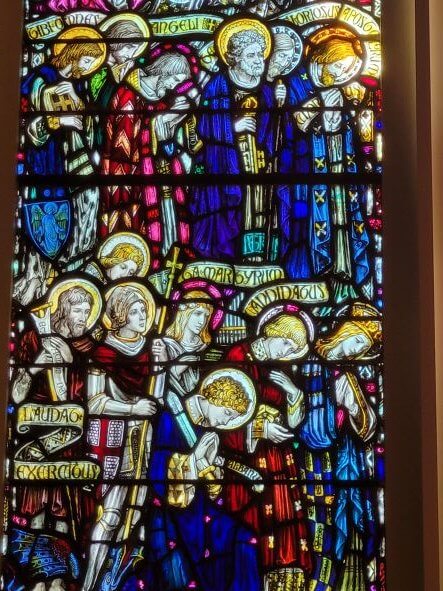
What’s Blocking Your Halo?
 Our gospel today tells the story of Jesus’ 40 days and nights in the wilderness. The first thing that the gospel tells us is that Jesus fasted, and at the end of his time in the wilderness, he was famished. We learn that Jesus fasted and was famished before we know anything about the three temptations the gospel tells us Jesus faced. But is fasting and self denial the big takeaway point here? After all, it’s a faith tradition in at least the Episcopal and American Catholic Churches to “give up” something for Lent to remember Jesus’ time in the wilderness. Jesus spends 40 days and nights in the wilderness confronting temptation to prepare for his earthly ministry. The first temptation has to do with earthly power, and control over his future. Sure, Jesus is fasting and hungry, but what the tempter actually says is If you are the son of God, then turn these stones into bread.
Our gospel today tells the story of Jesus’ 40 days and nights in the wilderness. The first thing that the gospel tells us is that Jesus fasted, and at the end of his time in the wilderness, he was famished. We learn that Jesus fasted and was famished before we know anything about the three temptations the gospel tells us Jesus faced. But is fasting and self denial the big takeaway point here? After all, it’s a faith tradition in at least the Episcopal and American Catholic Churches to “give up” something for Lent to remember Jesus’ time in the wilderness. Jesus spends 40 days and nights in the wilderness confronting temptation to prepare for his earthly ministry. The first temptation has to do with earthly power, and control over his future. Sure, Jesus is fasting and hungry, but what the tempter actually says is If you are the son of God, then turn these stones into bread.
The whole premise of the tempter’s if/then clause is about power and control, not fasting and self denial: If you are the son of God. It’s really only important that Jesus was fasting and famished to raise the stakes on the power play — for the temptation to have teeth, and for the tempter to be sure Jesus had skin in the game. Let’s say your favorite food is ice cream. Ok, let’s just be honest and say my favorite food is ice cream. And let’s say that I also love oysters and have eaten way more oysters than a polite person would. Then, the tempter offers me a bowl of ice cream. I have to say, after several dozen oysters — sadly, that’s not that much of an exaggeration — that I’m not facing a powerful urge. So Jesus had to be famished for the first temptation to matter.
Temptation
 Jesus’ 40 days and nights was about temptation — and not about fasting, and not entirely about the wilderness. We don’t know what Jesus did for the whole 40 days, but we do know the three temptations from this passage. Only the first really takes place in the wilderness. The second is on the top of the Temple in the center of Jerusalem. And the third is on a high mountain, looking out over all the kingdoms of the world.
Jesus’ 40 days and nights was about temptation — and not about fasting, and not entirely about the wilderness. We don’t know what Jesus did for the whole 40 days, but we do know the three temptations from this passage. Only the first really takes place in the wilderness. The second is on the top of the Temple in the center of Jerusalem. And the third is on a high mountain, looking out over all the kingdoms of the world.
And the whole time Jesus was in the wilderness, he was never more than a couple hours’ walk out to warmth, food, and shelter. It’s important to understand how accessible the wilderness was to Jesus, because it’s a place any of us can go any time to think and pray about our own temptations. For most of us, figuring out temptation through fasting is not about hunger, and whether we can keep our resolutions while we’re hungry, but about clearing all distractions so that we can identify our own motivations and keep our focus even when things get tough, and lots of distractions come into the picture.
What is temptation really? Oscar Wilde famously said, I can resist anything but temptation. In the wilderness, Jesus was facing temptation and wrestling with difficult priorities, like earthly power, ego, control over his future, and obedience to the life he was choosing. His famished fasting just raised the stakes on the wrestling match with the tempter — sweetened the pot, so to speak. How can we use Lenten fasting to keep our focus on our best intentions — on being the people of God we mean to be?
Haloes
 Looking out at the Emmanuel congregation last Sunday before the Annual Meeting, I saw haloes. We were all wearing them! Many of us use a halo emoji in text messages — 😇 — to signal our good intentions toward each other and the community. In scripture and in art, a halo is a disc or circle of light shown surrounding or above the head of a saint or holy person to represent their holiness. In Astronomy, a halo is a circle of light appearing to surround the sun, moon, stars or other planets that results from refraction or reflection of light by ice particles in the atmosphere. When we express our good intentions toward each other and the community, our very best hopes and dreams shine out around each of us like the circle of light that appears to surround the sun — warming, connecting, and including all touched by its glow.
Looking out at the Emmanuel congregation last Sunday before the Annual Meeting, I saw haloes. We were all wearing them! Many of us use a halo emoji in text messages — 😇 — to signal our good intentions toward each other and the community. In scripture and in art, a halo is a disc or circle of light shown surrounding or above the head of a saint or holy person to represent their holiness. In Astronomy, a halo is a circle of light appearing to surround the sun, moon, stars or other planets that results from refraction or reflection of light by ice particles in the atmosphere. When we express our good intentions toward each other and the community, our very best hopes and dreams shine out around each of us like the circle of light that appears to surround the sun — warming, connecting, and including all touched by its glow.
 Let’s make it our Lenten discipline to try to see each other’s haloes. We all have them, although we may sometimes hide them — maybe even from ourselves. The season of Lent reminds us of Jesus’ preparation in the wilderness for his earthly ministry of preaching, teaching, feeding, and healing with radical welcome and inclusion without exception. This holy — and wholly ordinary — work of living together in community is what we’re called to do at Emmanuel, where our very name means God with us.
Let’s make it our Lenten discipline to try to see each other’s haloes. We all have them, although we may sometimes hide them — maybe even from ourselves. The season of Lent reminds us of Jesus’ preparation in the wilderness for his earthly ministry of preaching, teaching, feeding, and healing with radical welcome and inclusion without exception. This holy — and wholly ordinary — work of living together in community is what we’re called to do at Emmanuel, where our very name means God with us.
What keeps us from seeing our own and each other’s haloes — those radiant crowns of our very best hopes and dreams for each other and our community? And how can we use our Lenten fast to focus on what really motivates us, so that we can see and show our haloes all the time? What gets in the way? Is it self-doubt? Distraction? Grief? Fear? Suspicion? Busy-ness? Self-righteousness? Waiting? Anger? Traffic? Litter? Masks? You tell me.
Seeing Haloes
 Each of you should have a purple ribbon. If you don’t, wave your hand, and I’ll bring you one. Please write on the ribbon what it is that keeps you from seeing your own and others’ haloes — those radiant crowns of our very best intentions for each other and our community. The ribbons will be collected in a basket at the offertory and offered to God and each other as part of our 40 days in the wilderness — as we get ready for our work in community of preaching, teaching, feeding, and healing, all with radical welcome and inclusion without exception.
Each of you should have a purple ribbon. If you don’t, wave your hand, and I’ll bring you one. Please write on the ribbon what it is that keeps you from seeing your own and others’ haloes — those radiant crowns of our very best intentions for each other and our community. The ribbons will be collected in a basket at the offertory and offered to God and each other as part of our 40 days in the wilderness — as we get ready for our work in community of preaching, teaching, feeding, and healing, all with radical welcome and inclusion without exception.
We’ll tie our purple, repentant ribbons on the fence to invite us all to see the world in a new way. And we’ll have another ribbon next week, and each week of Lent, as we consider our own, and others’ haloes. I invite you into a holy, haloed Lent, our season of preparation for our work together in community. Look for the haloes shining out around us like the circle of light that appears to surround the sun. Amen
Halo Questions:
- Week 1 (Purple): What keeps us from seeing our own and each other’s haloes? Self-doubt? Distraction? Grief? Fear? Suspicion? Busy-ness? Self-righteousness? Waiting? Anger? Traffic? Litter? Masks?
- Week 2 (Gold): What helps us to see our own and each other’s haloes? What leads to compassion? Gentleness? Curiosity? Hospitality? Asking for help? Helping others? Enough rest? Watching less news? More news? Reading scripture? Yoga? Prayer? Coming to church? Lunch with a friend? Remembering someone’s birthday? Smiling?
- Week 3 (Gaudete Sunday — Rose): How do we show our haloes — our good intentions — to the community? Soup’s On? Hydroponic gardening? Volunteering at Emmanuel or MLK? Voting? Attending Emmanuel and community events? Funerals? Radical hospitality — inviting all people from all places in all seasons into Emmanuel? Clear signage? Facebook/online/print news articles about Emmanuel? Conversation? Inviting a friend? Having an event at Emmanuel? Telling someone about Annie’s catering? [Rose Sunday]
- Week 4 (all colors/all saints/all sorts): What happens when we do show our haloes to the community, and we start seeing haloes where we never knew to look for them?
